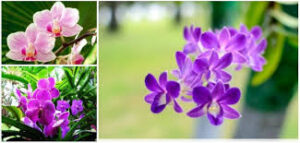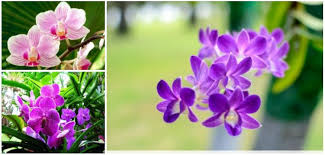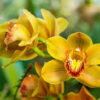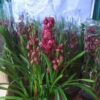# Nurturing Sato Cymbidium Orchids in Low Light Conditions

Sato Cymbidium orchids, known for their stunning blooms and vibrant colors, are a favorite among plant enthusiasts and florists alike. However, one of the challenges of growing these beautiful flowers is providing them with adequate lighting, particularly in homes or offices where natural light is limited. In this guide, we will explore the best practices for nurturing Sato Cymbidium orchids in low light conditions, ensuring they thrive and continue to produce their enchanting flowers.
## Understanding Sato Cymbidium Orchids
Before diving into care techniques, it’s important to understand what Sato Cymbidium orchids are and their natural growing conditions. Native to tropical and subtropical regions, Cymbidium orchids typically thrive in bright, indirect light. However, many gardeners find themselves in situations where natural light is scarce. Luckily, Sato Cymbidium orchids are adaptable and can flourish in lower light environments with the right care.
### Characteristics of Sato Cymbidium Orchids
Sato Cymbidium orchids are known for their large, showy blooms that come in various colors, including white, yellow, pink, and green. These orchids feature elongated leaves and can grow up to three feet tall, making them an attractive addition to any indoor space. They are epiphytic plants, meaning they naturally grow on other plants or surfaces rather than in the soil. In their natural habitat, they receive filtered light, which is essential for their growth and development.
### Importance of Light for Orchid Growth
Light is a crucial factor for plant growth as it directly impacts photosynthesis, the process by which plants convert light energy into chemical energy. While Sato Cymbidium orchids prefer bright light, they can adapt to lower light conditions if certain care requirements are met. Insufficient light can lead to several issues, including:
– **Poor Flowering**: Without adequate light, orchids may produce fewer flowers or none at all.
– **Weak Growth**: In low light, orchids may exhibit elongated stems and weak foliage as they stretch toward the light source.
– **Increased Vulnerability**: Insufficient light can make orchids more susceptible to pests and diseases.
## Best Practices for Nurturing Sato Cymbidium Orchids in Low Light Conditions
### 1. Assessing Light Levels
Before making adjustments to your Sato Cymbidium orchids’ environment, it’s essential to assess the available light levels in your space. Here are some ways to gauge light conditions:
– **Natural Light**: Observe how much natural light enters the room throughout the day. South-facing windows typically provide the most light, while north-facing windows offer the least. Rooms with limited windows or shaded areas may require additional lighting solutions.
– **Artificial Light**: If natural light is inadequate, consider the type of artificial light available. Fluorescent lights or LED grow lights can supplement natural light and provide the necessary spectrum for healthy orchid growth.
### 2. Choosing the Right Location
The placement of your Sato Cymbidium orchids is crucial for their overall health. In low light conditions, consider the following tips for selecting an optimal location:
– **Near Windows**: Position orchids near windows where they can receive filtered light. Use sheer curtains to diffuse direct sunlight, preventing leaf burn while still allowing some light to reach the plants.
– **Avoid Dark Corners**: While orchids can tolerate lower light, they should not be placed in dark corners or enclosed spaces. Ensure they have access to the best available light source.
– **Consider Shelving**: If natural light is limited, consider placing your orchids on shelving near windows or using stands that elevate the plants closer to light sources.
### 3. Utilizing Artificial Lighting
When natural light is insufficient, artificial lighting can play a vital role in nurturing Sato Cymbidium orchids. Here are some effective strategies for using artificial light:
– **LED Grow Lights**: These lights are energy-efficient and can provide the specific light spectrum that orchids need for photosynthesis. Position LED grow lights approximately 12-18 inches above the orchids, and run them for 12-16 hours daily to mimic natural daylight.
– **Fluorescent Lights**: Standard fluorescent lights can also work well for orchids in low light. Use cool white or full-spectrum bulbs to ensure your orchids receive the necessary light. Place them at a similar height as LED lights and adjust the duration of exposure as needed.
– **Timer Systems**: Implement a timer for your artificial lights to maintain a consistent light schedule. This will help mimic natural day and night cycles, promoting healthy growth.
### 4. Adjusting Watering Practices
In low light conditions, the water requirements of Sato Cymbidium orchids may differ from those grown in brighter environments. Here are some tips for adjusting your watering practices:
– **Reduce Watering Frequency**: Orchids in low light typically use less water since their growth rate is slower. Check the potting medium before watering; allow it to dry slightly between watering sessions. Overwatering can lead to root rot and other issues.
– **Monitor Humidity Levels**: Low light conditions can also affect humidity levels. Sato Cymbidium orchids thrive in higher humidity (around 40-60%). Use a humidity tray or a room humidifier to maintain optimal humidity levels, especially during dry seasons.
– **Avoid Water on Leaves**: Ensure that water does not accumulate in the crown or on the leaves, as this can lead to fungal diseases. Water directly into the potting medium and avoid overhead watering whenever possible.
### 5. Fertilizing for Optimal Growth
Proper fertilization is crucial for the health of Sato Cymbidium orchids, especially when growing in low light conditions. Here are some guidelines for fertilizing effectively:
– **Use Balanced Fertilizer**: Choose a balanced, water-soluble fertilizer formulated for orchids. A ratio of 30-10-10 or similar can provide essential nutrients. Dilute the fertilizer to half the recommended strength to avoid over-fertilizing.
– **Fertilization Schedule**: In low light conditions, orchids may require less frequent fertilization. Apply fertilizer every 4-6 weeks during the growing season (spring and summer) and reduce to every 8-12 weeks during the dormant period (fall and winter).
– **Flush the Potting Medium**: Periodically, flush the potting medium with plain water to remove any excess salts that may build up from fertilizer applications. This will help maintain a healthy growing environment.
### 6. Choosing the Right Potting Medium
The potting medium used for Sato Cymbidium orchids plays a significant role in their overall health, especially in low light conditions. Consider the following options:
– **Orchid Mix**: A well-draining orchid mix is essential for these epiphytic plants. Look for a blend that includes bark, perlite, and sphagnum moss to provide aeration and moisture retention without becoming waterlogged.
– **Repotting Considerations**: If your orchids have been in the same potting medium for an extended period, consider repotting them to refresh the medium. Repotting is best done in the spring after the blooming period.
– **Avoid Heavy Soils**: Avoid using heavy soils that retain too much moisture, as this can lead to root rot. Sato Cymbidium orchids prefer a loose, airy medium that allows for proper drainage.
### 7. Monitoring Plant Health
Regular monitoring of your Sato Cymbidium orchids is crucial for identifying potential issues early. Here are some tips for assessing plant health:
– **Inspect Leaves and Roots**: Regularly check the leaves for signs of discoloration, spots, or wilting. Healthy leaves should be firm and vibrant. Examine the roots by gently removing the orchid from its pot to look for signs of rot or dehydration.
– **Watch for Pests**: Low light conditions can lead to pest infestations. Inspect the plants for common pests such as aphids, mealybugs, and spider mites. Treat any infestations promptly with insecticidal soap or neem oil.
– **Assess Blooming Patterns**: Keep track of your orchid’s blooming patterns. Inadequate light can lead to poor flowering. If your orchids fail to bloom after a reasonable period, consider adjusting their lighting conditions.
### 8. Supporting Growth with Temperature Control
Temperature plays a significant role in the growth of Sato Cymbidium orchids. Maintaining appropriate temperature ranges can enhance their ability to thrive in low light conditions:
– **Ideal Temperature Range**: Sato Cymbidium orchids prefer daytime temperatures between 65°F to 75°F (18°C to 24°C) and nighttime temperatures between 50°F to 60°F (10°C to 15°C). Ensure that your growing environment falls within this range.
– **Avoid Extreme Temperatures**: Keep orchids away from drafts, heaters, or air conditioning vents that can create temperature fluctuations. Sudden temperature changes can stress the plants and hinder growth.
– **Utilize Heat Mats**: If your growing environment is cooler than ideal, consider using heat mats to provide gentle warmth to the root zone, which can help promote healthy growth and flowering.
### 9. Encouraging New Growth
In low light conditions, encouraging new growth is essential for the longevity of Sato Cymbidium orchids. Here are some tips for promoting healthy growth:
– **Support New Shoots**: When new shoots emerge, provide support by staking them if necessary. This will help them grow upright and prevent damage.
– **Encourage Keiki Formation**: Sato Cymbidium orchids can produce keikis (baby orchids) along the flower spikes. Allow these keikis to grow for several months before removing them and potting them separately.
– **Patience is Key**: Nurturing orchids in low light may require patience, as their growth may be slower. Monitor their progress and continue to provide optimal care to encourage healthy development.
### Conclusion
Nurturing Sato Cymbidium orchids in low light conditions may present challenges, but with
the right techniques and care, these beautiful flowers can thrive and produce stunning blooms. By assessing light levels, utilizing artificial lighting, adjusting watering practices, and providing proper nutrition, you can create an environment conducive to healthy orchid growth. Regular monitoring and maintenance will help you identify any issues early and ensure your Sato Cymbidium orchids remain healthy and vibrant. Embrace the beauty of these orchids, even in low light, and enjoy their elegance in your home or office. With dedication and the right strategies, you can successfully cultivate Sato Cymbidium orchids and experience the joy of their remarkable blooms, regardless of your lighting conditions.
# Nurturing Sato Cymbidium Orchids in Low Light Conditions (Part 2)
In the first part of this guide, we explored essential practices for nurturing Sato Cymbidium orchids in low light conditions, including assessing light levels, utilizing artificial lighting, and adjusting watering and fertilization routines. In this second part, we will delve deeper into specific techniques, strategies, and care tips to ensure these magnificent orchids thrive even in less-than-ideal lighting situations.
## 10. Utilizing Companion Plants
One effective strategy to enhance the growing conditions for Sato Cymbidium orchids in low light is to incorporate companion plants. Companion planting can improve humidity levels and create a more balanced microenvironment that benefits your orchids. Here’s how to use companion plants effectively:
### Choosing Suitable Companion Plants
– **Humidity Lovers**: Select plants that thrive in similar humidity conditions, such as ferns, peace lilies, or pothos. These plants can help maintain moisture in the air, which is crucial for Sato Cymbidium orchids.
– **Light Requirements**: Ensure that the companion plants you choose have similar light needs as your orchids. Select species that can thrive in low light without outcompeting your orchids for available light.
### Arrangement and Placement
– **Strategic Placement**: Arrange companion plants around your orchids to create a visually appealing display while enhancing humidity levels. Consider placing taller plants behind your orchids to provide them with some shade, mimicking their natural habitat.
– **Group Planting**: Consider grouping several plants together in a larger pot or a decorative container. This can create a mini-ecosystem that retains moisture and maintains humidity while providing visual interest.
## 11. Understanding Orchid Biology
A deeper understanding of the biology of Sato Cymbidium orchids can significantly improve your care practices. Knowing how these plants function in low light will help you tailor your approach to their specific needs.
### Photosynthesis in Low Light
– **Photosynthetic Adaptations**: Sato Cymbidium orchids have adapted to low-light environments by developing a more efficient photosynthetic process. They can absorb light energy more effectively, allowing them to thrive in conditions where other plants might struggle.
– **Light Saturation Point**: Understanding the light saturation point is crucial. Sato Cymbidium orchids will have a point at which they can no longer use additional light efficiently. Providing too much light can lead to leaf burn, while too little can hinder growth.
### Leaf Structure and Function
– **Leaf Morphology**: The structure of orchid leaves plays a significant role in their ability to capture light. Sato Cymbidium orchids have broad leaves that can maximize light absorption. Keeping these leaves clean and dust-free is essential for optimal light absorption.
– **Transpiration and Water Uptake**: In low light, orchids may transpire less, leading to reduced water uptake. It’s essential to monitor moisture levels closely and adjust watering practices accordingly to avoid overwatering or underwatering.
## 12. Creating a Seasonal Care Routine
Establishing a seasonal care routine can greatly enhance the health of your Sato Cymbidium orchids in low light conditions. Different seasons can affect light availability, temperature, and humidity levels.
### Spring: The Growing Season
– **Increased Light Exposure**: As daylight hours increase, assess your orchids’ light exposure. If necessary, adjust their placement to take advantage of the improved light conditions.
– **Fertilization Boost**: In spring, increase your fertilization frequency to support new growth. Use a balanced fertilizer at half-strength every four weeks.
– **Repotting Considerations**: If your orchids have outgrown their pots, consider repotting in spring. This will help refresh the potting medium and allow for healthy root development.
### Summer: Maintaining Humidity
– **Humidity Control**: During the summer months, monitor humidity levels closely. If your indoor environment is air-conditioned, use a humidifier or humidity trays to maintain optimal moisture levels.
– **Pest Vigilance**: Summer can bring pests. Regularly inspect your orchids and companion plants for signs of infestation, and treat any issues promptly.
### Fall: Preparing for Dormancy
– **Gradual Light Adjustment**: As daylight decreases, gradually adjust your orchids’ exposure to light. This will help them acclimate to the changing conditions.
– **Reduced Watering**: Decrease watering frequency as your orchids prepare for dormancy. Monitor their needs and adjust accordingly to avoid overwatering.
### Winter: Care in Low Light
– **Artificial Lighting**: As natural light diminishes, rely on artificial lighting to maintain healthy growth. Use grow lights for 12-16 hours daily to ensure your orchids receive enough light.
– **Temperature Monitoring**: Keep an eye on temperature fluctuations. Sato Cymbidium orchids prefer a stable environment; avoid placing them near drafts or heating vents.
## 13. Emphasizing Proper Air Circulation
Air circulation is a critical factor in the health of Sato Cymbidium orchids, especially in low light conditions. Adequate airflow helps prevent mold and fungal diseases, which can thrive in humid environments.
### Improving Airflow
– **Ventilation Fans**: Consider using small fans to promote air circulation around your orchids. Position them to provide gentle airflow without blowing directly on the plants, which can cause stress.
– **Spacing Plants**: Ensure adequate spacing between your orchids and companion plants. This will allow for better airflow and reduce the risk of fungal diseases.
### Monitoring Humidity Levels
– **Hygrometers**: Use a hygrometer to monitor humidity levels in your growing environment. Maintaining humidity between 40-60% is ideal for Sato Cymbidium orchids.
– **Avoiding Stagnant Air**: Regularly check for stagnant air pockets in your growing area. If necessary, rearrange your plants to improve airflow and ensure they receive adequate ventilation.
## 14. The Role of Temperature in Growth
Temperature is another critical factor that can influence the health of Sato Cymbidium orchids in low light. Understanding how temperature affects their growth can help you create an optimal environment.
### Optimal Temperature Ranges
– **Daytime Temperatures**: Sato Cymbidium orchids thrive in daytime temperatures between 65°F to 75°F (18°C to 24°C). Maintaining this range will support healthy growth and flowering.
– **Nighttime Temperatures**: At night, temperatures should drop to between 50°F to 60°F (10°C to 15°C). This temperature differential helps promote flowering and overall plant health.
### Monitoring Temperature Fluctuations
– **Use Thermometers**: Place thermometers in your growing area to monitor temperature fluctuations. This will help you make necessary adjustments to maintain optimal conditions.
– **Avoid Extreme Conditions**: Ensure your orchids are protected from extreme temperatures, whether from heating or cooling systems. Place them away from drafts, radiators, or air conditioning vents.
## 15. Training and Grooming Orchids
Training and grooming Sato Cymbidium orchids can enhance their appearance and promote healthy growth. Proper grooming practices also contribute to maintaining optimal light absorption.
### Pruning Techniques
– **Removing Dead or Damaged Leaves**: Regularly inspect your orchids for dead or damaged leaves. Prune these away to promote healthier growth and prevent disease.
– **Cutting Flower Spikes**: After flowering, cut back the flower spikes to encourage new growth. This will help direct the plant’s energy toward producing new leaves and roots.
### Staking for Support
– **Using Stakes**: As your orchids grow, they may require staking for support. Use stakes to help keep tall spikes upright and prevent them from bending or breaking.
– **Gentle Ties**: When staking, use soft ties or clips to avoid damaging the stems. Ensure they are secure but not too tight to allow for natural movement.
## 16. Troubleshooting Common Issues
Even with the best care, Sato Cymbidium orchids may face challenges in low light conditions. Being able to identify and troubleshoot common issues will help ensure their longevity.
### Signs of Light Stress
– **Leaf Yellowing**: Yellowing leaves may indicate insufficient light or overwatering. Adjust your light exposure and monitor your watering practices.
– **Stretched Growth**: If your orchids are growing leggy with elongated stems, it’s a sign they are reaching for light. Consider repositioning them to a brighter location or using artificial lighting.
### Addressing Pests and Diseases
– **Common Pests**: Monitor your orchids for common pests such as aphids, mealybugs, and spider mites. Use insecticidal soap or neem oil for treatment.
– **Fungal Diseases**: Overly humid conditions can lead to fungal diseases. Ensure proper air circulation and avoid overwatering to reduce the risk of these issues.
## 17. Advanced Techniques for Orchid Care
For those looking to take their orchid care to the next level, consider exploring advanced techniques that can help enhance the growth and blooming of Sato Cymbidium orchids.
### Hydroponic Growing
– **Hydroponics Basics**: Consider hydroponic systems for growing orchids. Hydroponics eliminates soil, allowing for more controlled nutrient delivery and moisture management.
– **Nutrient Solutions**: Use specialized orchid nutrient solutions tailored for hydroponic growing to ensure your orchids receive the necessary nutrients.
### Cloning and Propagation
– **Keiki Propagation**: Sato Cymbidium orchids can produce keikis (baby orchids) along the flower spikes. Allow them to grow until they develop roots, then separate and pot them individually.
– **Division Method**: If your orchids are well-established, consider dividing them into smaller sections during repotting. This can help rejuvenate the plant and create new growth opportunities.
## 18. Celebrating the Beauty of Sato Cymbidium Orchids
Taking the time to nurture Sato Cymbidium orchids in low light conditions is a rewarding experience. The stunning blooms and elegant foliage bring beauty to any space, even in challenging
lighting.
### Showcasing Your Orchids
– **Display Options**: Experiment with different display options to highlight the beauty of your orchids. Use decorative pots, hanging baskets, or plant stands to create an eye-catching arrangement.
– **Combining with Other Decor**: Consider incorporating your orchids into your home decor. Pair them with candles, art pieces, or other plants for a cohesive look.
### Sharing the Experience
– **Engaging with the Orchid Community**: Join local orchid societies or online forums to connect with other orchid enthusiasts. Sharing experiences and tips can enhance your orchid-growing journey.
– **Educating Others**: Share your knowledge about Sato Cymbidium orchids with friends and family. Host workshops or presentations to inspire others to appreciate the beauty of these remarkable plants.
## Conclusion
Caring for Sato Cymbidium orchids in low light conditions may present challenges, but with the right knowledge and techniques, you can create an environment where these stunning flowers thrive. By understanding their biology, monitoring environmental factors, and utilizing effective strategies, you can cultivate beautiful orchids that add elegance and vibrancy to your space. Embrace the beauty of Sato Cymbidium orchids and enjoy the rewarding experience of nurturing them, even in less-than-ideal lighting conditions. With dedication, patience, and love, you can achieve stunning blooms and a flourishing orchid collection that will bring joy for years to come.


